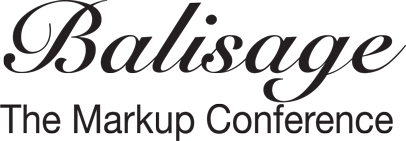Friday, February 14th
| Time | Room RB209 | Room RB210 | Room RB211 |
| 9:00–9:30 | Registration | ||
| 9:30–11:00 | Publishing track | Localization track | eXist-db Users Meetup |
| 11:00–11:30 | Coffee break | ||
| 11:30–13:00 | Publishing track | Semantics track | eXist-db Users Meetup |
| 13:00–14:30 | Lunch | ||
| 14:30–16:00 | oXygen Users Meetup | BaseX Users Meetup | eXist-db Users Meetup |
| 16:00–16:30 | Coffee break | ||
| 16:30–18:00 | oXygen Users Meetup | BaseX Users Meetup | eXist-db Users Meetup |
Detailed agenda
Publishing track
chaired by Romain Deltour
| 9:30 | Using transpect for converting and checking IDML, OOXML, EPUB, … Gerrit Imsieke |
This session will introduce the concepts behind le-tex transpect and demonstrate use cases.
transpect is an open source XProc/XSLT framework for converting and checking XML and XML-based file formats, such as EPUB, OOXML (.docx), IDML (InDesign), and XHTML. transpect makes it easy to enforce typesetting and editorial conventions (images must be anchored, references must be cited, etc.), and it is easy to maintain different rule sets for different publications, accommodating the inevitable variations in styles and input quality that we see in book publishing, particularly. |
| 10:30 | XProc Q&A, XProc problem solving session Jim Fuller |
chaired by Romain Deltour
| 11:30 | Publishing DITA for Mobile Delivery Hal Trent |
As DITA comes to full maturity, organizations seek publishing solutions that are more robust than PDFs and static HTML. They seek robust solutions that deliver interactive content to the web, mobile devices, and e-readers. As the future of publishing moves away from paper-based deliverables to electronic, fully searchable, and customizable deliverables, the need to understand the DITA publishing architecture for electronic delivery becomes increasingly important. In this session, Hal Trent, will discuss the importance of a mobile strategy for your current DITA content and the steps necessary to add mobile to your organization’s content delivery strategy. |
| 12:30 | Print and Page Layout Community Group @ W3C Tony Graham |
Update on the activities of the Print and Page Layout Community Group (PPL CG) at W3C and demonstrations of the XSLT extension functions developed by the CG for running an XSL-FO formatter from within the XSLT transformation to make decisions based on sizes of formatted areas. |
Localization track
chaired by Felix Sasaki
| 10:00 | XLIFF 2.0 David Filip |
XLIFF is an industry vocabulary that aims to help keep bilingual content in sync during Localization and Translation service transformations. XLIFF means XML Localization Interchange File Format and is the only Open standard bitext file format available in the industry, hence a pivotal format for data exchange in the language services industry. The session is intended as a crash intro into the issues of XML presentation of bilingual (source and target) content that often does not originate in XML or otherwise well formed ML environments. We assume that the target audience are XML experts who are however not very well aware of the challenges connected to multilingual publishing or bitext management. The goal of the session is twofold:
|
Semantics track
chaired by David Filip
| 11:30 | XML, Semantic Web and Content Analytics Felix Sasaki |
The session will introduce basic concepts of content analytics: a set of technologies to make sense of content, for applications in the realm of business intelligence, web analytics and many others. Both structured and unstructured data can be input to content analytics processes. In the session we to discuss potential roles XML and RDF tool and data processing chains can plain and gather feedback from the XML developer community. |
eXist-db Users Meetup
oXygen Users Meetup
BaseX Users Meetup
Welcome to the third BaseX Users Meetup! Similar to last year, you will have the great chance to listen and talk to other users and developers of BaseX. We will first give a quick insight into BaseX for newcomers, then show you how to use the system in offline and online contexts, and introduce new features. Finally, we’d like to discuss with you what direction you would like BaseX to go in the future.
| 14:30 | BaseX: 12 months, 12 updates Christian Grün |
|
| 15:00 | Using BaseX for off-the-cuff queries Michael Sperberg McQueen |
|
| 15:30 | BaseX as a corpus tool Lars Johnsen |
|
| 16:30 | Using BaseX with RESTXQ as the storage back-end for a Web-based XML editor Gerrit Imsieke |
|
| 16:55 | Data Heterogeneity with XQUERY++ and BaseX Jean-Marc Mercier |
|
| 17:20 | BaseX for rapid Minimum Viable Product prototyping Yoann Maingon |
|
| 17:45 | Open Discussion |
Location
The pre-conference day takes place in the same venue as the conference. However it is situated in the different building. It is best to use campus entry from the Italská street. You can see entrance and explore area using Google Streetview.
Just use entrance from Italská street and continue straight inside building until you reach atrium. Then use stairs to go one floor up and then look around for room RB209, RB210 or RB211 (alternatively you can use elevators on the left side and go to the floor marked as 2 on the control panel).












